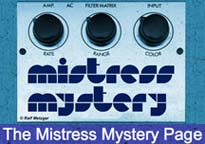The Big Muff π Page
The Definitive Big Muff Resource and History
There used to be an old Big Muff Mods and Tweaks page at this address (http://rkerkhof.ruhosting.nl/Taas/Mods/Big%20Muff.htm), deleted in 2015. It was one of the first Big Muff circuit mod pages and one I referred a lot of people to, so a big thanks to Rogier Kerkhof, who created the page (See note at the bottom of this page about the authorship). I felt it was important to keep it alive on the internet so below is a recreation of that page from an archive I kept - KR
The Big Muff was one of the first pedals I ever bought. Drawn to it by the legend, the name, the number of users and the tone. I never tried it out in the store, it had to be loved! When I first plugged it in (into a crappy SS amp) I was disimpressed; was this the legendary Muff? Did everyone love THIS pedal??? Luckily she grew on me, I learned to control her and to get those nice tones from it. Now, I could not live without one Muff.....
Over the years, many many versions were made but the basic circuit stayed in the pedal producing the very known sound. The Muff is basically a four transistor fuzz pedal with 2 gainstages (with diodes in a feedback loop), an in and output buffer and a tone section containing the combination of a high pass and low pass filter. The big disadvantage of this tone design is the loss of mids. I will use the next schematic (GGG - top schematic) as a referrence point in this document. Big Muff Page Note: Use the GGG schematic for mods on this page. The Electro-Harmonix scheamtic under it matches the cap and resistor numbers printed on early Big Muff pcbs and is the one used elsewhere on the Big Muff Page website, so use it as a cross reference.
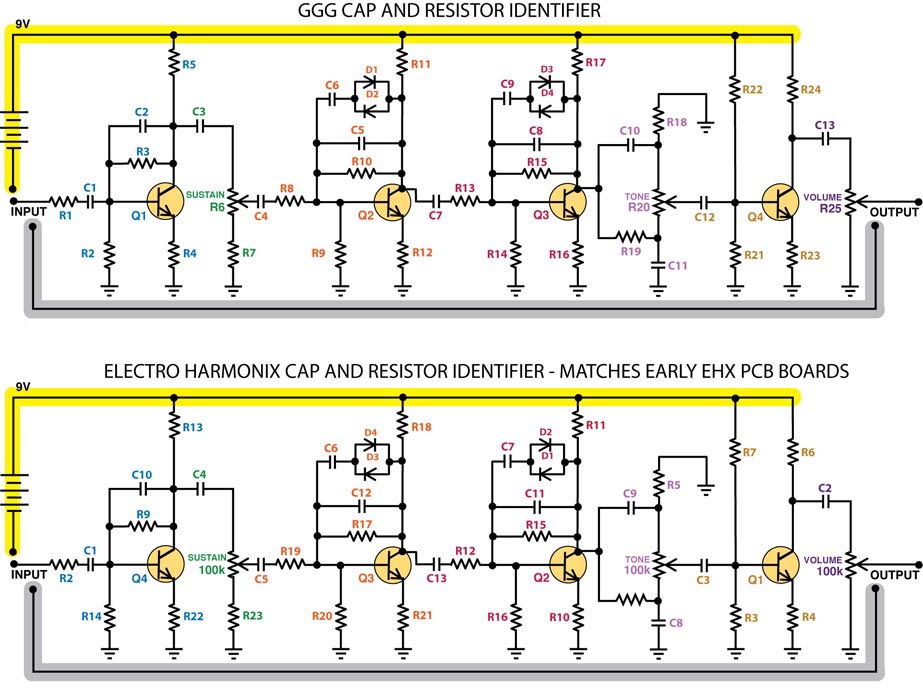
Link for Stock Schematic from General Guitar Gadgets, used for mods on this page.
Over the years I learned what makes a Muff tick, and yes, I still am learning. Here I grouped some known mods to make this fuzz sound even better! I grouped em in EASY MODS, TONE MODS and VERSION MODS.
EASY MODS
Diode mods: The Muff contains 4 diodes, 2 pairs, in a known orientation that clipping and compression occur. Changing these diodes result in the change of the overal sound. Some examples:
-
Silicon diodes - normally, the Muff will contain 4x 1N4148 diodes (or similar devices). These silicon diodes provide smooth, tight compression and are used here as a reference value.
-
The 2006 NYC reissue models use 1N6263 silicium Schottky diodes. These diodes cut the sound less then stock silicons and add a bit less compression. Result: sound is less compressed, louder, tighter and will lean more to the treble side. Nice new approach to the muff sound.
-
Germanium diodes - germanium diodes cut the sound more and add a tad more compression to the sound. Result: sound is less loud, more compressed and a bit more gainy.Sometimes an octave effect can be heard. No germanium diodes were used in original Muffs.
-
LED's - LED's are also simple diodes. In the Muff they cut the sound even less then the Schottky's and add less compression. Result: more volume, less compression / less gain.
-
FET's / MOSFET's - these units can also be used as diodes when the drain and the gate are taken together. Sound is similar to silicons only a bit more smoother
-
No diodes - great trick! By removing the diodes from the unit no sound if fed back. Result: more volume (LOUD!), less compression, less gain and a more open (overdrive) sound. By removing only the first two diodes (of the first stage) the bass response of the unit will become much greater when Sustain increases (great for bass players!). This trick is also done to the Colorsound Supa Tonebender, which is basically a Muff with the first diodes removed.
Small addition: as the unit uses a pair of diodes you can experiment with different diodes per pair to get more complex sounds, nice touches or just "YOUR" sound! Any diode will work here, properly orientated.
Emitter mod: The 2 gain stages of the Muff are tied to the groud by emitter resistors (R12 & R16). These are 390 ohms in Russian models and 100 ohms in NYC models (exact value can differ between models). Jumpering these resistors (replace resistors with a wire) will increase "gainy-ness" of the unit, enlarging em will reduce the "gainy-ness" of the unit. A potmeter can be used to control this value although I noticed I usually used only one setting.
Resistor mod: Each of the gain stages has a limiting resistor on the start of it (R8 & R13). These are 8.2k (8k2) or 10k in different models. By enlarging these values the unit gets more gainy.
Creamy Dreamer: basically the combination of the Emitter mod and the Resistor mod. NOTE: The actual Creamy Dreamer pedal has no limiting resistor mod, but all three emitter resistors (R4, R12 & R16) were removed and jumpered. The tone stage was modified with matching 47k high pass and low pass resistors at R18/R19.
Noise gate mod: This mod will quieten the Muff while not playing, thus a noise gate. To do this, add a 100k trimpot (wired as a variable resistor) parallel to the 100k to ground of the second gain stage (R14). The trimpot can be adjusted to taste to get the max noise gate effect.
Coupling caps mod: The Muff has a lot of coupling caps (C1, 3, 4, 7, 16, 12 & 13). Coupling caps are next to the block of DC also a way to set the frequency response of the unit. Enlarging these caps give the unit more bass, making em smaller give the unit more treble. Experiment with em. Also the sort of caps can make a difference in noise, feeling and authenticity. Old Muffs used ceramic coupling caps; using film caps here won't give you the same sound.
High roll-off mod: Notice those small ceramic caps on 3 of the transistor stages? They are used to roll of excessive highs. Normally they are 470 pF (C2, 5 & 8) but larger values roll of more highs. You can also remove em for a great result.
Clipping caps mod: Next to the diodes is also a cap placed (C6 & 9). This cap determines the frequency band the unit clips. Enlarging this cap will make it clip more low notes, make it smaller for more high end clipping.
Transistor mod: The Muff uses four transistors and the type and choice of these transistors will affect the sound greatly. The higher the gain, the more the unit will focus on the high end / treble. Some known examples:
-
The Russian Muff uses E type transistors (newer ones use BC549C's though) which has a Hfe of around 500. I used BC184's as a great replacement of these transistors.
-
The NYC Muffs usually use 2N5088's or BC550's with a Hfe of around 800.
-
The Little Big Muff uses 2N5962 with a Hfe of around 1500 - 2000.
The Russian sounds darker due to the low gain. Knowing this, we can change the sound of a muff greatly by replacing the transistors. Small tip: use sockets when changing transistors. This way the transistors are not damaged by the soldering and swapping is much much easier. Some nice ones:
-
2N5133's; used in Triangle ones (the NOS versions tend to sound even better then newer ones) as FS36999's. Very nice sound, smooth, warm, open.One of my favs!
-
BC239's; also used in a bunch of Muffs around. Slight less gain as the above named but this gives the Muff quite a nice touch.
-
2N5087's; PNP transistors instead of the above named NPN (more usualble). To use these you need to reorient some of the caps and change the + and - of the battery (called positive ground). Although they must be identical to 2N5088's they were used in some old models and do sound different.
-
BC141's; ultra low Hfe (around 100) and not suited for anyone out there. More bass, less gain but a very different sound.
-
MPSA13's; ultra high Hfe (around 10.000). Nice touch for some more gain.
Experiment! Use four of the same transistors or try to mix. For example I like a Muff with 5133's for the clipping stages and MPSA13's for the buffer stages.
Feedback mod: This mod is also not for anyone. It will give the Muff a weird drone note that will interact with the notes played resulting in octaves (up and down), nintendo sounds or a huge MUSH. Can sound quite nice and interesting!!!!! The mod is done with a feedback loop: connecting two points together and letting signal flow back. I found two of these loops in my Muff (note: more can be there; try for yourself!)
-
Connect the emitter of Q3 with the emitter of Q2 through a switch (so you can turn the loop off). The sustain will be on full when this mod is engaged.
-
Connect the collector of Q3 with the collector of Q1 through a switch. The sustain now can be varied by the sustain knob.
Great addition: add a 1M potmeter in the loop (wired as a variable resistor) or, even better!!, a LDR (light dependent resistor). With the latter, you can control the amount of feedback with the light on stage / with your foot shading the LDR from the light. Cool!
Reference pics:


NYC BIG MUFF

RUSSIAN BIG MUFF
Tone Stack mods:
The Big Muff Pi is legendary due to his tone section; only one knob to select between a bass, treble or in-between setting. The overall sound of this tone knob is the loved / hated mid cut.
 original from DIYstompboxes
original from DIYstompboxes
Some Versions :
- Triangle version: R1=33k, C1=4n, R2=33k, C2=10n;
- Ramshead version: R1=33k, C1=4n, R2=22k, C2=10n;
- 1975 version: R1=39k, C1=4n, R2 = 22k, C2=10n;
- 1977 opamp version (1): R1=5.6k, C1=100n, R2=1.2k, C2=120n;
- 1977 opamp version (2): R1=8.2k, C1=100n, R2=1.2k, C2=120n;
- Green Russian version: R1=20k, C1=3.9n, R2=22k, C2=10n;
- Late model: R1=39k, C1=4n, R2=100k, C2=10n
- Reissue version: R1=22k, C1=3.9n, R2=22k, C2=10n;
- Little Big Muff version = reissue version.
And then some different mods:
- Swollen Pickle: R1=33k, C1=3.3n, R2 = 22k, C2=47n;
- Flat mids: R1=33k, C1=5.6n, R2=33k, C2=5.6n;
Small note: these differences in models won't produce a very different sound but will only complete the total picture of the Muff! For a more difference in sound try the above easy mods!
Mid control mod: This mod is beloved by both guitar players as by bassplayers to regain the mids in the sound, mids that are so needed to be heard in the mix. With the next control you can dial in anything from a (huge) mid cut to a mid boost. Note that by boosting the mids you'll lose the Muff's character; still, it is a very nice addition!
-
Replace C1 with a 22n cap
-
Replace R2 with a 22k to 25k potmeter (wired as a variable resistor) with a 1k resistor wired in series.
This mod was designed by Jack Orman from AMZFX / Muzique.com. Great site with a lot of information!
Small note 2: the pictures in the Frequency Response page were made with the Freeware program Duncan Amp tools Tone Stack calculator, dowloadable here. I can recommend anybody tampering with the tonestack to check this out for a direct view of what the tone stack does to the sound. And hey, it is free!
Tone stack bypass mod: By bypassing the tonestack the tonestack has no influence anymore on the sound thus does not color the signal in it's own way. Great way to get a more middy tone from your Muff. As the tone stack also cuts volume you get a volume increase
Tone stack complete mod: One of my most fav mods. Remove the tone stack altogether from the Muff and place a three band EQ circuit in it's place. Works like a charm and gives you more control over the sound! I also once added a Boss GE-7 in this place to give total control over the sound.
Frequency Response of Some Versions : The next figures were made with the Duncan Tone Stack Calculator. These graphs show the range of sound pressure levels in Decibels (dB) vertically (low loudness at bottom, high at top) and the Hertz (Hz) frequencies (low to high) horizontally. The frequency range shown is 10Hz to 10,000Hz (10kHz), which is within the range of human hearing. Basically the bass frequencies include 20Hz - 500Hz, midrange frequencies 500Hz - 5000Hz, and high frequencies 5000Hz - 10,000Hz. The three lines stand for:
Top Line = Minimum Tone knob setting;
Middle Line = 50% Tone knob setting;
Bottom Line - Maximum Tone knob setting.
-
Triangle version: R1=33k, C1=4n, R2=33k, C2=10n;
-
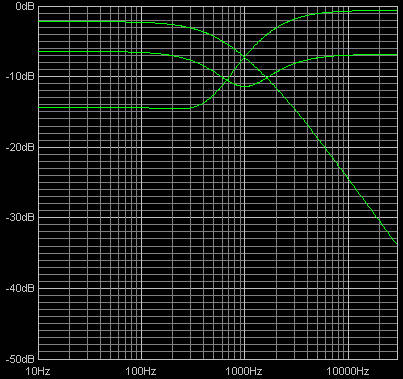
-
Ramshead version: R1=33k, C1=4n, R2=22k, C2=10n;
-
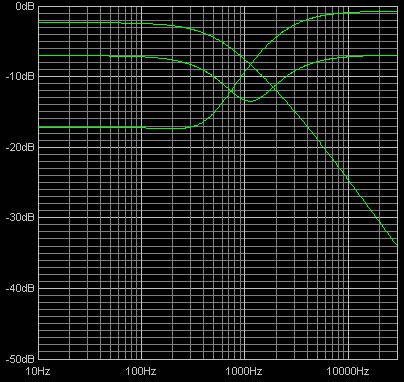
-
1975 version: R1=39k, C1=4n, R2 = 22k, C2=10n;
-
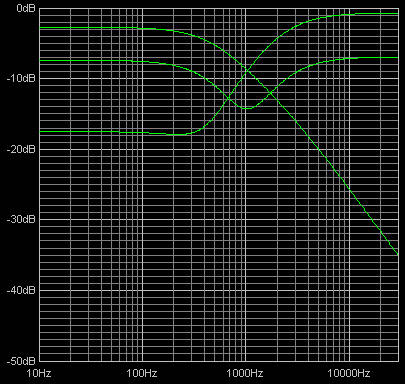
-
1977 opamp version (1): R1=5.6k, C1=100n, R2=1.2k, C2=120n;
-
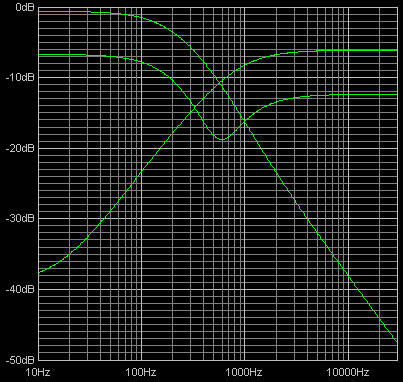
-
1977 opamp version (2): R1=8.2k, C1=100n, R2=1.2k, C2=120n;
-
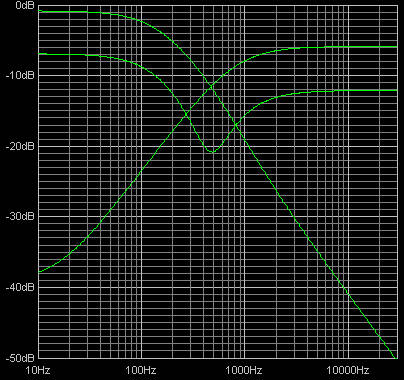
-
Green Russian version: R1=20k, C1=3.9n, R2=22k, C2=10n;
-
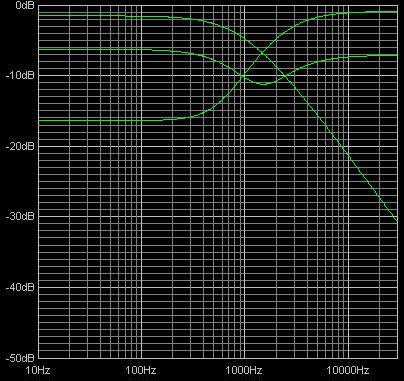
-
Late model: R1=39k, C1=4n, R2=100k, C2=10n
-
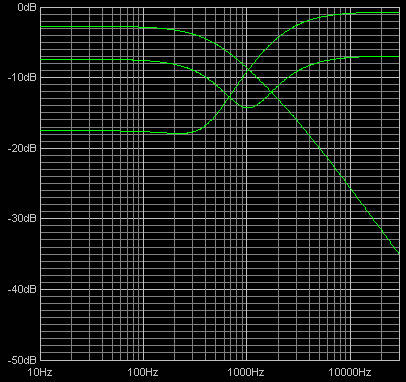
-
Reissue version: R1=22k, C1=3.9n, R2=22k, C2=10n;
-
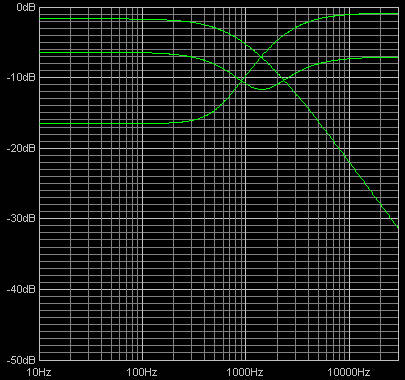
And then some different mods:
- Swollen Pickle: R1=33k, C1=3.3n, R2 = 22k, C2=47n;
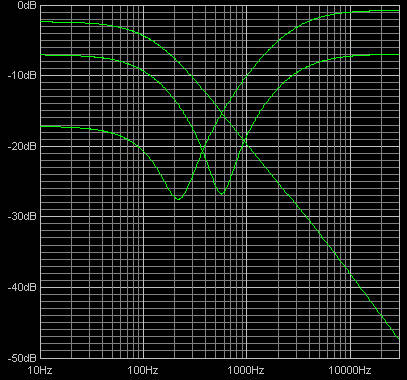
- Flat mids: R1=33k, C1=5.6n, R2=33k, C2=5.6n;
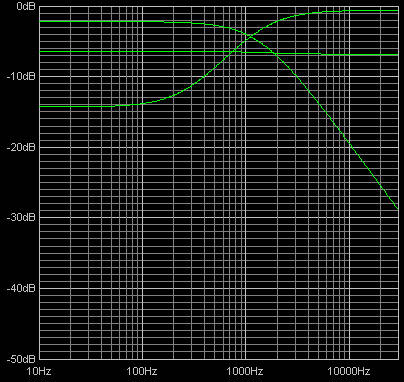
Version mods:
Over the years the models of the Big Muff changed. Here I will post some schematics of the different models so you can alter the values on your Big Muff and transform it into a different version. Here goes: NOTE - none of the links below work any longer, so I will direct you to my Big Muff Page schematic page HERE instead, which includes many more Big Muff schematics than the original links. The component numbering system used on this page does not match the system used on my schematics. The two schematics at the top of this page can be used to cross reference which component is which - KR
Author - Rogier Kerkhof
NOTE ABOUT THE AUTHOR - A poster from the Netherlands using the forum name Berarduur (from the old Geekchat website) or Bernardduur (from the DIY Stompboxes website) compiled this mods page back in June 2006, based on his experiments modding Big Muffs, so all thanks go to him. It was hosted on a Dutch website. The original page had no © notice or credit or contact info, and he is no longer active on forums, so this page is posted without permission. If anyone has his contact info, or if you are the author, please let me know so I can confirm or give the proper credit, or link to the original page if it has been moved to another hosting site. nasnandos @ kitrae.net



